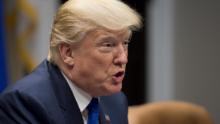CNN.com
Trump on North Korean missile launch: 'We will take care of it'
Washington (CNN)President
Donald Trump told reporters at the White House on Tuesday that the
United States "will handle" the situation in North Korea after the rogue
nation launched yet another intercontinental ballistic missile earlier
in the day.
"We will take care of it," Trump said, adding later that North Korea "is a situation that we will handle."
The
Pentagon confirmed earlier Tuesday that North Korea launched what the
US military believes to be an intercontinental ballistic missile.
Secretary
of Defense Jim Mattis told reporters that the North Korean missile test
went "higher, frankly, than any previous shot they have taken."
Mattis
made remarks as he sat in on a meeting with Trump, House Speaker Ryan
and Senate Majority Leader McConnell. The defense secretary added that
North Korea has the ability to hit "everywhere in the world basically."
Pentagon
spokesperson Col. Rob Manning told reporters that the missile was
"launched from Sain Ni, North Korea, and traveled about 1,000 kilometers
before splashing down in the Sea of Japan, within Japan's Economic
Exclusion Zone."
"The North
American Aerospace Defense Command (NORAD) determined the missile launch
from North Korea did not pose a threat to North America, our
territories or our allies," Manning added.
CNN also confirmed the launch with the South Korean military leaders.
"North
Korea fired an unidentified ballistic missile early this morning from
Pyongsong, South Pyongan, to the east direction. South Korea's Joint
Chiefs of Staff is analyzing more details of the missile with the US
side," said an official at South Korea's Joint Chiefs of Staff.
South
Korea's Joint Chiefs of Staff said the South Korean military carried
out a "precision missile strike drill" just minutes after North Korea's
missile launch.
The precision
missile strike matched the flight distance of the North Korean missile
and landed in waters off the east coast of South Korea.
South
Korea's Joint Chiefs of Staff added that its counter drill tested a
scenario of simultaneously hitting a target through the land, air and
sea, but did not elaborate further.
"South
Korea apparently used this launch to prove it has the ability to hit
the North's mobile missile launchers or leadership targets," according
to Adam Mount, a senior fellow at the Federation of American Scientists
who previously worked as a senior fellow at the Center for American
Progress.
"It is a measured and
pointed response but also a reminder that the peninsula remains on hair
trigger alert, he told CNN. "In this situation, provocations or even
mistakes could quickly escalate out of control."
White
House press secretary Sarah Sanders said on Twitter that President
Donald Trump "was briefed, while missile was still in the air, on the
situation in North Korea."
Guam's
Homeland Security/Office of Civil Defense posted on Facebook that they
were notified that North Korea "conducted a ballistic missile launch"
but there is no immediate threat to them or the Marianas.
The
missile was launched from the west part of North Korea and is likely to
have landed in Japan's Exclusive Economic Zone after flying for about
50 minutes, according to Masaki Hikida, public relations officer from
Japan's Ministry of Defense.
A
50-minute flight time would also suggest that this was a major ICBM test
"possibly in operational settings" and should "disabuse US officials
from thinking military displays, sanctions, or threats are deterring
North Korean tests," according to Mount.
"Today's
test proves that Pyongyang still feels able to test at will," he told
CNN, adding it also shows the Trump administration "has to get serious
about deterring an atmospheric nuclear test."
North
Korean Foreign Ministry Ri Yong Ho hinted in September that Pyongyang
could carry out an atmospheric nuclear test over the Pacific Ocean,
possibly by strapping a warhead atop a missile or dropping it from an
airplane.
US defense and
intelligence officials had been growing increasingly puzzled as to why
North Korean leader Kim Jong Un had not tested a ballistic missile since
September.
Before
Wednesday's test, North Korea had fired 22 missiles without active
warheads during 15 tests since February. US officials say North Korea is
continuing to develop its missiles, rocket fuel and engines, as well as
targeting and guidance systems.
The
US believes Pyongyang may be able to put a miniaturized warhead on a
missile sometime in 2018 -- giving it the theoretical capability to
launch a missile with a warhead atop that could attack the US.
North Korea has launched missiles at an unprecedented rate in 2017.
Pyongyang
tested two missiles in July that demonstrated intercontinental range.
It is currently testing a more advanced version of its existing ICBM, a
US official told CNN earlier this month.

















No comments:
Post a Comment